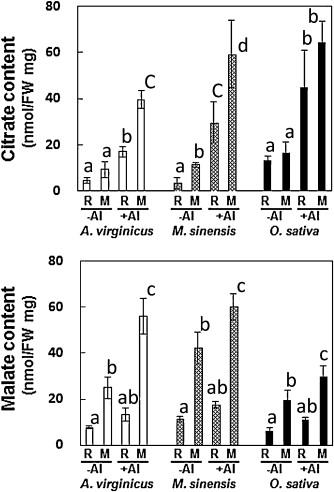A combination of five mechanisms confers a high tolerance for aluminum to a wild species of Poaceae,Andropogon virginicus L. |
| |
| Affiliation: | Institute for Plant Science and Bioresources, Okayama University, 2-20-1, Chuo, Kurashiki, Okayama 710-0046, Japan |
| |
| Abstract: | 
How can high tolerance against aluminum (Al) toxicity be obtained in plants? To address this question, tolerant mechanisms were characterized in a highly Al tolerant wild species of Poaceae, Andropogon virginicus L. A. virginicus showed an Al-stress-induced synthesis and secretion of citrate and malate in roots. This mechanism may help to suppress an increase of toxic Al ions in the root region. Microscopic observation of the morin-stained leaves indicated that the Al transferred to shoots was specifically accumulated in the trichomes and spikes of the leaves and that some portion of the accumulated Al was furthermore secreted as sap from the tips of trichomes. Al-induced synthesis of poly-phenolic compounds including anthocyanin also occurred in roots as a long term response to Al toxicity and anthocyanin production did not co-localize with either Al accumulation, nitric oxide (NO) production or lipid peroxides production in the roots. It was suggested that oxidative damage caused by Al stress was suppressed in these areas where anthocyanin was localized. Moreover, induction of NO production occurred in roots within 24 h of Al treatment. Our results suggested that NO could not efficiently ameliorate the Al-dependent nuclei deformation and DNA fragmentation, but could function as a trigger to stimulate anti-peroxidation enzymes under Al stress. Collectively the results suggested that A. virginicus manifests its high Al tolerance by a unique combination of effective mechanisms. |
| |
| Keywords: | Aluminum (Al) stress Anthocyanin Nitric oxide (NO) Organic acid Oxidative stress Trichome |
| 本文献已被 ScienceDirect 等数据库收录! |
|

